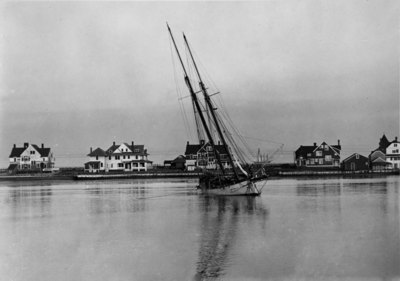Shrewsbury Packet
Besides steamboats, the Navesink and Shrewsbury rivers also were served by low draft center board schooners. There is very little information on these vessels, and NMHA is presently performing historical research on this vessel type to determine if it would be possible to design and build a Shrewsbury packet replica.
At this stage we have the following information, most of which was found in June Methot's book “Up and Down the River”.
The Shrewsbury Packets were the culmination of the commercial sailing era on the Navesink River. The first packets sailed in the 1830's and last packet sailed in the very early years of the twentieth century, and none are known to survive today.

So far, this is the winner in the Shrewsbury Packet beauty contest. Courtesy of Dorn's Classic Images
The Shrewsbury rivers suffered severely from shoals and the river even changed its course on a few occasions, sometimes draining directly into the Atlantic Ocean and sometimes draining to the Raritan Bay (or more precisely, Sandy Hook Bay)

This boat is grounded and therefore shows the dead rise of the bottom. Courtesy of Dorn's Classic Images
The vessel type was a variation of the American Coastal schooner, but of extremely low draft and with a centerboard. These vessels were reported to be between 60 and 85 feet long and measured at between 40 and 140 tons.
There were also smaller sloop rigged vessels at between 20 and 40 tons.
Since those who are working this project love schooners we will concentrate on the schooner version.
Shallow draft schooners were built in many US locations, and were reputed to be less seaworthy than deep draft schooners. This makes reasonable sense, since low draft tends to result in less stability at high angles of heel and results in a flatter bottom that can result in pounding in waves, but that does not have to always be true.
One of the interesting challenges in this project will be to try to design a low draft schooner that at the same time will pass United States Coast Guard stability requirements without suffering from being under canvassed. The intent is to design a replica vessel that looks as much as possible like a Shrewsbury packed including her rigging. We don't want a boat that is shallow draft, but that only can spread a handkerchief for sail.
June Methot's book shows some Shrewsbury Packet photos, but even better, Kathy Dorn of Dorn's Classic Images own the original glass negatives, which allows us to pick out tiny photo details.
This page shows some of the photos and clicking on the photo's credit will get you to the Dorn's NMHA gallery, where there are more. They are low resolution, if you would like to have high resolution prints contact Kathy Dorn at Dorn's Classic Images.
From inspection of the available photos it can be seen there were some very pretty packets and we are looking forward to pick the best features of the bunch. It appears all the packets had very straightforward rigs consisting of double or triple shrouded main and fore masts, no running backstays, topmasts with top sails only on the main mast and jumbo jibs.
There is also a photo that shows a late packet being wheel steered, which is nice since tiller steering on the these barndoor rudders is hard work.
The jumbo jibs are set to heavy bow sprits which in turn indicates that the headstays were set to the bow sprit ends. This makes the vessels very maneuverable since the jib can be easily tacked. This is a prime requirement on the Shrewsbury river, which is no picnic for a boat of this size. But it also can result in spectacular rig failure if the bowsprit is carried away. (Something like this happened recently on the new PRIDE OF BALTIMORE.)
Nautical research is a funny thing. One of my all time favorite boats is MAGIC, the first America's Cup defender. Long before I ever began to think of Shrewsbury Packets I have had a picture of MAGIC above my bar. I love MAGIC for her illustrious history; she was a racer, but also one of the most successful wreckers in Key West and she was a prototypical New York area schooner (although born as a sloop in Philadelphia). She was a small (88 feet) fast and shallow draft centerboard schooner and her rig except for foretopmasts and yankee was identical to the Shrewsbury Packets. She was built in 1857 and in racing trim exists as a model in the NYYC. In essence MAGIC was a racing Shrewsbury Packet!
So here is the exciting part: MAGIC's lines are on file at the New York Yacht Club. Our first job will be to see if MAGIC is USCG certifiable. If it looks like it can be done, we will have both a Shrewsbury Packet and a boat that might just dominate the Governor's Cup.
This is going to be a fun game. If you want to play contact Rik van Hemmen.
I am also taking suggestions for a name for the boat. MAGIC PACKET? SHREWSBURY MAGIC? MAGIC MOLLY (As in Molly Pitcher) Or maybe there is a donor who would like to name her after a loved one?
